A mass for asymptotically complex hyperbolic manifolds
A mass for asymptotically complex hyperbolic manifolds
A mass for asymptotically complex hyperbolic manifolds
You also want an ePaper? Increase the reach of your titles
YUMPU automatically turns print PDFs into web optimized ePapers that Google loves.
hal-00429306, version 1 - 2 Nov 2009<br />
14 A MASS FOR ASYMPTOTICALLY COMPLEX HYPERBOLIC MANIFOLDS.<br />
Proof. We first observe that<br />
DD ∗ = D 2 +(m + 1) 2 = ∇ ∗ ∇ + 1<br />
4 Scal +(m + 1)2 ≥ ∇ ∗ ∇ + m + 1.<br />
A slight adaptation of Proposition I.3.5 in [Biq] then shows that the operator<br />
DD ∗ : e br C 2,α −→ e br C 0,α<br />
is an isomorphism <strong>for</strong> every b such that m − √ m 2 + m + 1 < b < m + √ m 2 + m + 1.<br />
Since Dφ = (Dg −DCH m)φ = O(e−(a−1)r ), with a > m+ 1<br />
2<br />
, we can pick a b > m+ 1<br />
2 such<br />
that the equation DD ∗ σ = −Dφ0 admits a solution σ in e br C 2,α . Then φerr := D ∗ σ is<br />
convenient. <br />
We then invoke a Weitzenböck <strong>for</strong>mula, proved in paragraph 3 of [Her] (modulo two<br />
misprints, indeed: in the <strong>for</strong>mula stated, an i should be added at the second and third<br />
lines and the coefficient m − 2q and the fourth one should be replaced by 2(m − q)) :<br />
<br />
<br />
<br />
∗ζψ,ψ = <br />
SR<br />
BR<br />
ˆ <br />
<br />
∇ψ<br />
2<br />
+ 1<br />
<br />
(Scal +4m(m + 1)) |ψ|<br />
4 BR<br />
2<br />
<br />
+ (m + 1) |ψ| 2 − Ω<br />
πl−1ψ 2 − Ω<br />
πl ψ 2 ,<br />
BR<br />
where SR denotes the sphere {r = R}, bounding the domain BR, and ζσ,τ is the 1-<strong>for</strong>m<br />
defined by<br />
ζσ,τ(X) = ( ˆ ∇Xσ + c(X)Dσ,τ).<br />
In view of this <strong>for</strong>mula, the obstruction <strong>for</strong> ψ<br />
to be a Kählerian Killing spinor is precisely<br />
the “<strong>mass</strong> integral at infinity” limR→∞ SR ∗ζψ,ψ, which is a well defined element of<br />
[0,+∞], because the integrand on the right-hand side is non-negative.<br />
<br />
<br />
Lemma 3.3 — lim<br />
R→∞<br />
∗ζψ,ψ = lim<br />
R→∞<br />
∗ζφ,φ.<br />
SR<br />
SR<br />
Proof. Since Re ζσ,τ is symmetric up to a divergence term (as noticed in [Her], p.651),<br />
we only need to check that<br />
<br />
lim ∗(ζφ,φerr + ζφerr,φerr ) = 0.<br />
R→∞<br />
SR<br />
This follows from the following estimates : vol SR = O(e2mr ), ˆ ∇φ = O(e (1−a)r ) (beware<br />
φ grows in er ), φerr = O(e−br ), ˆ ∇φerr = O(e−br ) (cf. lemma 3.2), with a > m + 1<br />
2 and<br />
b > m + 1<br />
2 . <br />
In order to compare the metrics g et g0 := gCHm, we introduce the symmetric<br />
endomorphism A such that g0 = g(A.,A.). Since A maps g0-orthonormal frames to<br />
g-orthonormal frames, it identifies the spinor bundles defined with g and g0 (cf. [CH]<br />
<strong>for</strong> instance). The associated Clif<strong>for</strong>d products cg and cg0<br />
are related by the <strong>for</strong>mula<br />
cg(AX)σ = cg0 (X)σ. Note we will also write X· <strong>for</strong> cg0 (X) (and not <strong>for</strong> cg(X)). For<br />
the sake of efficiency, we will write u ≈ v when u −v = o(e −2mr ) ; the terms we neglect<br />
in this way will indeed not contribute to the integral at infinity. Be<strong>for</strong>e computing the<br />
“<strong>mass</strong> integral at infinity”, we point out a few elementary facts.<br />
Lemma 3.4 — A −1 JA ≈ J.


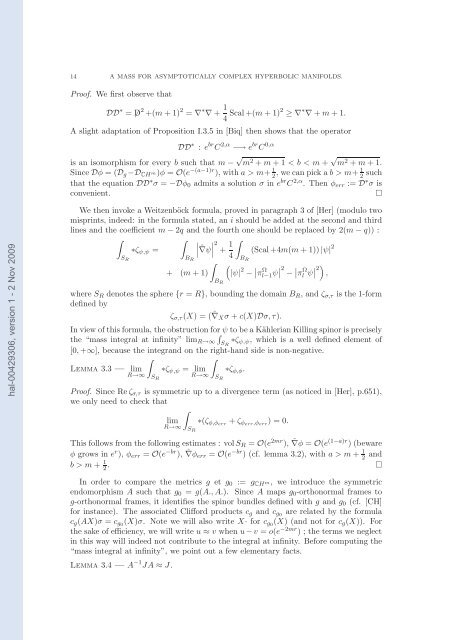

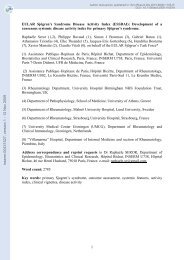
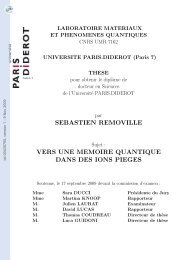
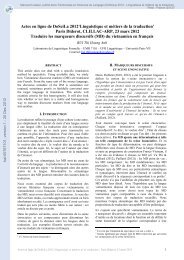
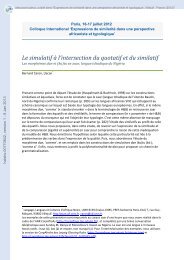
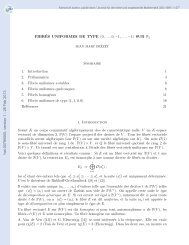
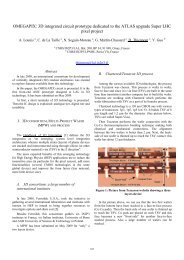
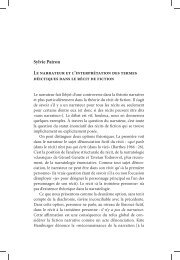
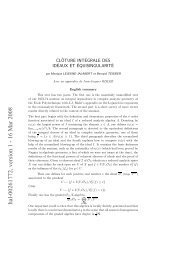
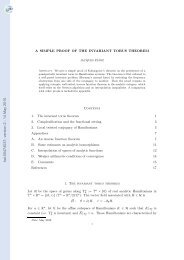

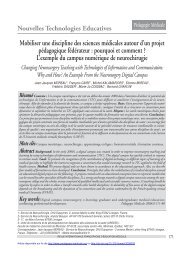

![[tel-00433556, v1] Relation entre Stress Oxydant et Homéostasie ...](https://img.yumpu.com/19233319/1/184x260/tel-00433556-v1-relation-entre-stress-oxydant-et-homeostasie-.jpg?quality=85)